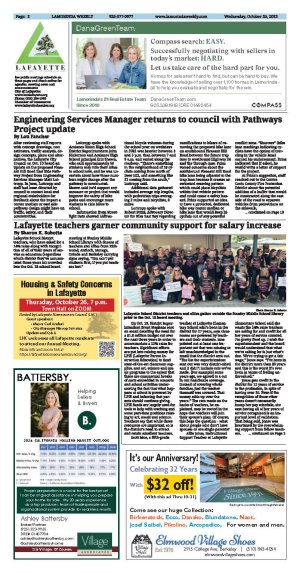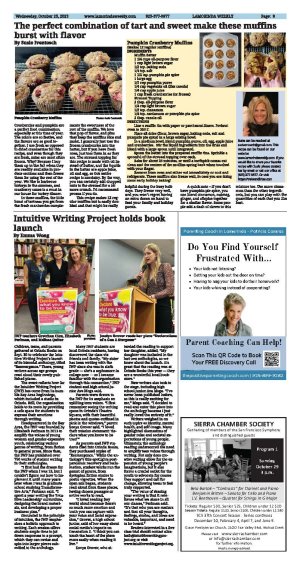| | Published October 25th, 2023
| Engineering Services Manager returns to council with Pathways Project update
| | | By Lou Fancher | | |
After reviewing staff reports with concept drawings, cost estimates, traffic analysis, design concepts, plans and alternatives, the Lafayette City Council on Oct. 10 heard an update on the proposed Pleasant Hill Road East Side Pathway Project from Engineering Services Manager Matt Luttropp. In June, Luttropp and staff had been directed by council to contact local and regional stakeholders for feedback about the impact a center median or east side pathway design might have on traffic, safety, and their communities.
 Luttropp spoke with Acalanes Union High School District Superintendent John Nickerson and Acalanes High School principal Eric Shawn, who said approximately 50 students may ride their bikes to school now, and he was uncertain about how those numbers might change after the pathway is constructed. Shawn said he'd support any measure or project that would improve the safety of bike paths and encourage more students to ride bikes to school.
Luttropp spoke with Acalanes Union High School District Superintendent John Nickerson and Acalanes High School principal Eric Shawn, who said approximately 50 students may ride their bikes to school now, and he was uncertain about how those numbers might change after the pathway is constructed. Shawn said he'd support any measure or project that would improve the safety of bike paths and encourage more students to ride bikes to school.
 Information from Streetlight Data showed bidirectional bicycle volumes during the school year on weekdays in 2021 was heavier between 3 and 5 p.m. than between 7 and 9 a.m. and varied along the roadway. "There's something in the neighborhood of 18 cyclists coming from north of Deer Hill, and something like 21 coming from the south," Luttropp said.
Information from Streetlight Data showed bidirectional bicycle volumes during the school year on weekdays in 2021 was heavier between 3 and 5 p.m. than between 7 and 9 a.m. and varied along the roadway. "There's something in the neighborhood of 18 cyclists coming from north of Deer Hill, and something like 21 coming from the south," Luttropp said.
 Additional data gathered included average trip lengths, with pedestrian trips averaging 2 miles and bicyclists, 6 miles.
Additional data gathered included average trip lengths, with pedestrian trips averaging 2 miles and bicyclists, 6 miles.
 Luttropp spoke with Robert Prinz, Advocacy Director for Bike East Bay regarding ramifications to bikers of removing the proposed bike lane on southbound Pleasant Hill Road between the future trap lane to westbound Highway 24 and the through-lane. Prinz voiced concerns about the southbound Pleasant Hill Road bike lane being adjacent to the trap lane because it creates an awkward weaving pattern which could place bicyclists within that vehicle pattern and could cause a safety hazard. Prinz supported an idea to have a protected, dedicated bike way center median or bike lane that would keep bicyclists out of any potential conflict zone. "Sharows" (bike lane markings indicating cyclists have the option of traveling in the vehicle lane) earned his endorsement. Prinz indicated that if asked, he would write a letter of support for the project.
Luttropp spoke with Robert Prinz, Advocacy Director for Bike East Bay regarding ramifications to bikers of removing the proposed bike lane on southbound Pleasant Hill Road between the future trap lane to westbound Highway 24 and the through-lane. Prinz voiced concerns about the southbound Pleasant Hill Road bike lane being adjacent to the trap lane because it creates an awkward weaving pattern which could place bicyclists within that vehicle pattern and could cause a safety hazard. Prinz supported an idea to have a protected, dedicated bike way center median or bike lane that would keep bicyclists out of any potential conflict zone. "Sharows" (bike lane markings indicating cyclists have the option of traveling in the vehicle lane) earned his endorsement. Prinz indicated that if asked, he would write a letter of support for the project.
 At Prinz's suggestion, staff reached out to the Contra Costa County Fire Protection District about the potential addition of a buffer that would be constructed along the east side of the road to separate vehicles from pedestrians on the sidewalk.
At Prinz's suggestion, staff reached out to the Contra Costa County Fire Protection District about the potential addition of a buffer that would be constructed along the east side of the road to separate vehicles from pedestrians on the sidewalk.
 Fire Marshall Chris Bachman said he preferred a design that allows fire trucks and other emergency vehicles to travel on the left side of the road in any direction and have all the cars pull to the right side. With the construction of the center median pathway, some of that access for cars to provide more space for emergency vehicles would be compromised, especially in the southern portion of the pathway. Lafayette Police Chief Ben Alldritt said his primary concerns were emergency evacuations during which people would be heading from the southbound side toward the freeway (not past or away from it).
Fire Marshall Chris Bachman said he preferred a design that allows fire trucks and other emergency vehicles to travel on the left side of the road in any direction and have all the cars pull to the right side. With the construction of the center median pathway, some of that access for cars to provide more space for emergency vehicles would be compromised, especially in the southern portion of the pathway. Lafayette Police Chief Ben Alldritt said his primary concerns were emergency evacuations during which people would be heading from the southbound side toward the freeway (not past or away from it).
 The real time-consuming aspect, Luttropp said, was to contact Caltrans. The city engineering staff and council members Teresa Gerringer and Susan Candell met with Greg Currey, the Caltrans Pedestrian and Bicycle Branch Chief for District 4. They reviewed the project's various configurations and Currey was in favor of the ideas presented, including the center median pathway, an east side pathway with and without signalized on and off ramps, elimination of slip lanes at Mt. Diablo and Pleasant Hill Road, and installation of raised crosswalks at the on- and off-ramps. He indicated that Caltrans would only conduct one courtesy review of the project and after that, any further reviews would need to be part of a formal encroachment permit application after the project plans are 100% completed.
The real time-consuming aspect, Luttropp said, was to contact Caltrans. The city engineering staff and council members Teresa Gerringer and Susan Candell met with Greg Currey, the Caltrans Pedestrian and Bicycle Branch Chief for District 4. They reviewed the project's various configurations and Currey was in favor of the ideas presented, including the center median pathway, an east side pathway with and without signalized on and off ramps, elimination of slip lanes at Mt. Diablo and Pleasant Hill Road, and installation of raised crosswalks at the on- and off-ramps. He indicated that Caltrans would only conduct one courtesy review of the project and after that, any further reviews would need to be part of a formal encroachment permit application after the project plans are 100% completed.
 The process for obtaining the permit was confirmed by Caltrans staff and would require considerable time and a document explaining how and why the plan deviates from Caltrans' standards - the pathway plan does differ in multiple ways - which could impact approval of the project. Email correspondence with Mark Wong, project manager for Caltrans, indicated the Highway Operations office would ask for extensive information related to the idea of signalizing the Highway 24 on-off ramps. Luttropp said that caused him to be notably concerned, because heavy traffic in the area often has cars on the ramps backing up onto Pleasant Hill Road. Luttropp said a study about the matter would cost about $30,000.
The process for obtaining the permit was confirmed by Caltrans staff and would require considerable time and a document explaining how and why the plan deviates from Caltrans' standards - the pathway plan does differ in multiple ways - which could impact approval of the project. Email correspondence with Mark Wong, project manager for Caltrans, indicated the Highway Operations office would ask for extensive information related to the idea of signalizing the Highway 24 on-off ramps. Luttropp said that caused him to be notably concerned, because heavy traffic in the area often has cars on the ramps backing up onto Pleasant Hill Road. Luttropp said a study about the matter would cost about $30,000.
 Luttropp said no additional information was anticipated and the alternatives remain viable. He invited input and direction from the council.
Luttropp said no additional information was anticipated and the alternatives remain viable. He invited input and direction from the council.
 Council Member Gina Dawson asked about the median not meeting Caltrans' standard width. Luttropp said near Mt. Diablo Boulevard, the median on Pleasant Hill Road is the standard 12 feet wide, but under the freeway it dips down to 7 feet and then down to 4 feet in some areas.
Council Member Gina Dawson asked about the median not meeting Caltrans' standard width. Luttropp said near Mt. Diablo Boulevard, the median on Pleasant Hill Road is the standard 12 feet wide, but under the freeway it dips down to 7 feet and then down to 4 feet in some areas.
 "The beautiful thing is that if we do the center median project, we have a 12-foot median," he said.
"The beautiful thing is that if we do the center median project, we have a 12-foot median," he said.
 In addition to council's extended discussion, public comment on the project had residents encouraging the city to do more research and acquire additional input from the local community about the project. The suggested alternative solutions short of constructing a center median were numerous.
In addition to council's extended discussion, public comment on the project had residents encouraging the city to do more research and acquire additional input from the local community about the project. The suggested alternative solutions short of constructing a center median were numerous.
 Council's closing conversation involved whether or not to pursue one of the design alternatives now, if traffic signals should or should not be included and studied, could the design plans they are considering be made more robust, and the efficacy of staff making an attempt to gain access to CCTA's vision of the Pleasant Hill Road corridor and what that might mean in terms of funding, They voted unanimously to carry the matter forward and asked staff to bring another updated report to the Nov. 13 meeting.
Council's closing conversation involved whether or not to pursue one of the design alternatives now, if traffic signals should or should not be included and studied, could the design plans they are considering be made more robust, and the efficacy of staff making an attempt to gain access to CCTA's vision of the Pleasant Hill Road corridor and what that might mean in terms of funding, They voted unanimously to carry the matter forward and asked staff to bring another updated report to the Nov. 13 meeting. |
| | | | | | | | | | | | |



